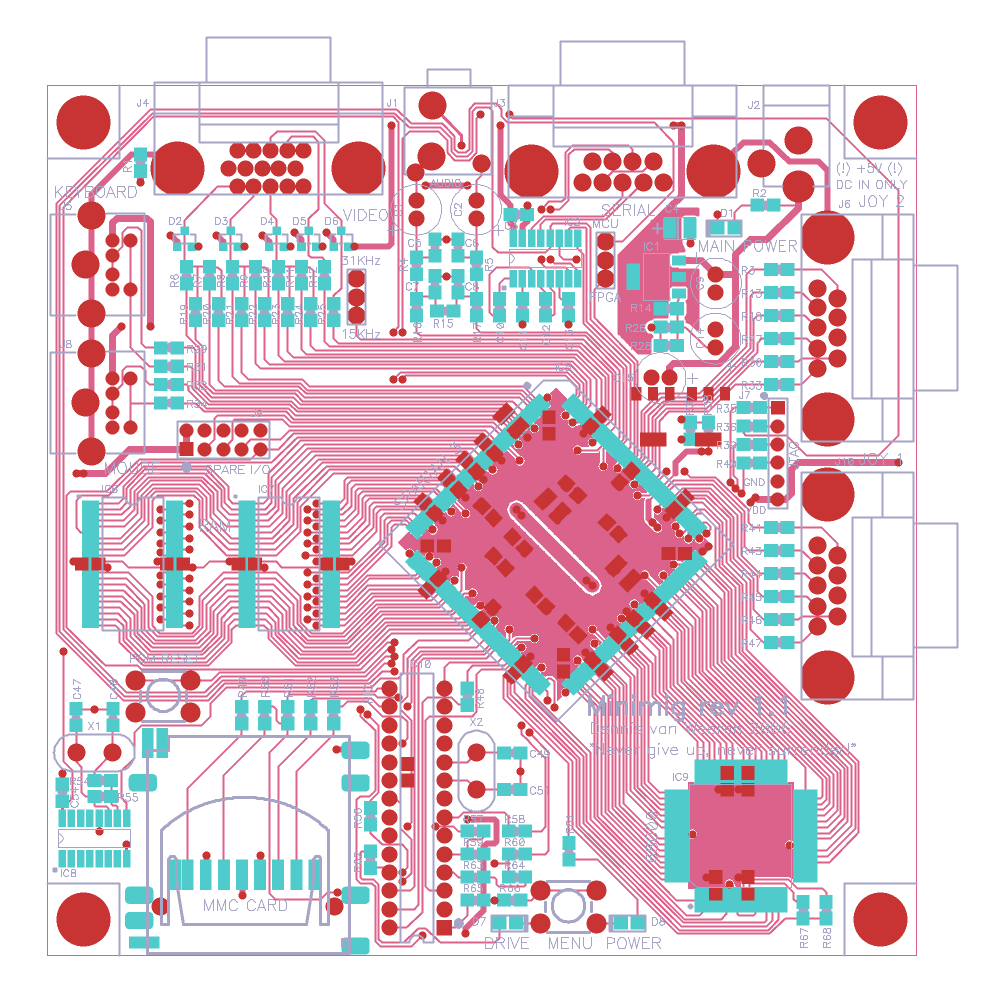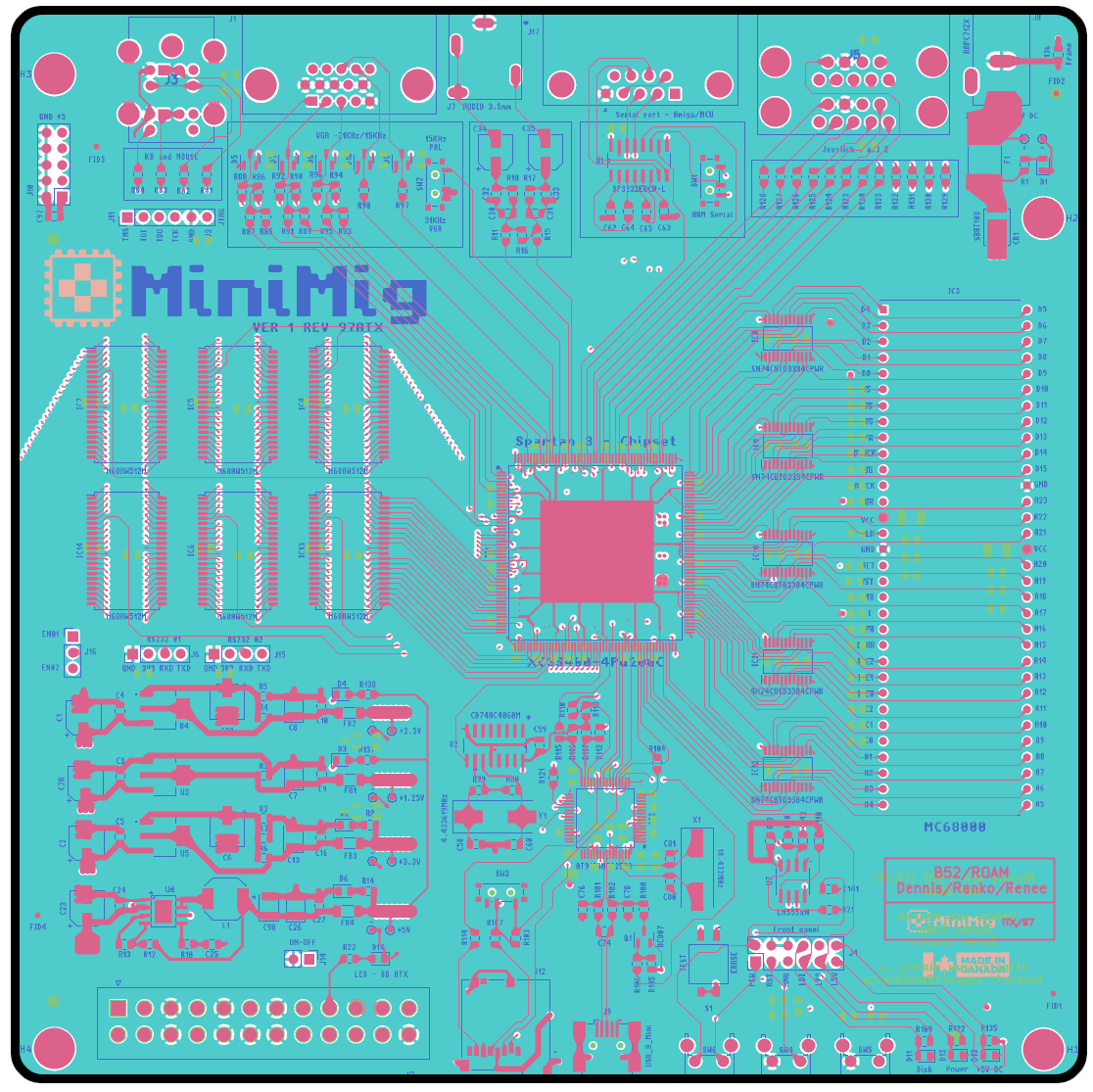I am excited to provide you with a centralized hub where you can access and download the source code and fabrication files for Minimig. Whether you’re a developer, a hardware enthusiast, or simply curious about the inner workings of this iconic retro computer, this page is your go-to resource.
On this page, you’ll find a comprehensive collection of resources related to Minimig, allowing you to dive deep into its technical details and even customize and enhance its functionality. We believe in the power of open-source collaboration, and our mission is to foster an environment where enthusiasts can freely explore, contribute, and build upon the Minimig project.
In addition to the source code, we are also offering fabrication files for Minimig, which include the necessary schematics, PCB layouts, and other resources needed to build your own Minimig board. With these files, you can embark on an exciting journey of creating your very own Amiga replica, or perhaps even experiment with modifications and enhancements to push the boundaries of this retro marvel.
Few words about the contributors.
First and foremost, I owe a tremendous debt of gratitude to Renee Cousins (https://www.buffee.ca/about/) for her invaluable ideas and support. Renee played a pivotal role in the development of the DIP64 variant of Minimig, which has expanded the possibilities and versatility of this remarkable retro computing platform. Her innovative thinking and expertise have shaped the project in profound ways. Moreover, her crucial support during the early stages of the project provided the foundation upon which I could embark on this exciting journey. Without Renee, the Minimig project would not be what it is today.
I also extend my utmost appreciation to Dennis van Weeren (https://www.techtravels.org), the genius behind the Minimig project. Dennis’s incredible dedication and technical prowess have allowed us to relive the magic of the Amiga platform through Minimig. His ability to reverse engineer the Amiga chipset and create the now-famous Minimig core is nothing short of remarkable. Dennis’s work has become an integral part of countless Amiga projects and has rekindled a sense of nostalgia for enthusiasts worldwide.
I would like to express my sincere gratitude to Evangelos Logaras for his invaluable assistance in integrating 2MB of fast RAM into Minimig 1.97itx. Evangelos, an electronic engineer hailing from Athens, Greece, possesses an impressive academic background. He obtained his B.Sc. in Electronic Engineering in 2004, followed by his M.Sc. degree in 2007 and Ph.D. degree in 2015, both focused on “Microelectronics/Hardware Design.”With over 10 years of industry experience and a passion for research, Evangelos has acquired a deep understanding of high-level synthesis for digital ASIC/FPGA design and verification, as well as expertise in embedded systems. His contributions to our project were crucial in its success, and I am truly grateful for his dedication and expertise. For those interested in learning more about Evangelos’s work and research interests, I highly recommend visiting his personal website at https://cgi.di.uoa.gr/~evlog/.
Special thanks are extended to the exceptionally skilled members of the Grovety team: Alex Straystar (VWarlock) for his expertise in enhancing voltage regulation, Alexey Spirkov (AlSp) for his invaluable contributions to architectural improvements, and Andrey Lifar (c0da) for his dedicated engagement in MIA/ARM FPGA development. Through their collective efforts, Minimig compatibility with PiStorm and TF030 has been significantly enhanced. I wholeheartedly appreciate their invaluable assistance.
Finally, I would like to extend a special thanks to Chris Edwards, whose support and promotion have been instrumental in the development of this project. As a customer and true Amiga hardware and software expert, Chris has played a significant role in shaping the direction of our work. We encourage you to check out Chris Edwards’ YouTube channel, where he shares his passion for Amiga restoration and showcases the rich history of this iconic platform. You can find his channel at Chris Edwards’ YouTube Channel.
Live long and prosper!
Ranko Rodic
minimig.ca

Minimig v1.1
| minimigJ_source_04_08_2008.zip | These are all Verilog, C and Assembly sources for Jakub’s improved Minimig core. |
| minimigJ_build_04_08_2008.zip | Jakub’s improved Minimig firmware and core builds, read the readme!. |
| minimig1_source_27_04_2008.zip | These are all Minimig Rev1.x Verilog, C and Assembly sources. |
| minimig1_build_27_04_2008.zip | Latest Minimig Rev 1.x firmware and core builds. |
| minimig1_man.pdf | Once you have built a Minimig Rev1.x, you’ll need a manual! |
| S2VRLG_15_07_2007.zip | These are the source and project files for the S19 to Verilog translation tool. The project can be opened with Dev CPP (see links section). |
| minimig11_schematics.pdf | These are the Minimig Rev1.1 schematics. |
| minimig11_gerbers.zip | The Minimig Rev1.1 gerbers. |
| minimig1_bom.txt | Minimig Rev1.x bill of materials. |
| DE1_Minimig12c.zip | Minimig ported to the Terasic Altera DE1 board with softcore 68000! |
| DE2_Minimig12c.zip | Minimig ported to the Terasic Altera DE2 board with softcore 68000! |

Minimig v1.5
| Minimig15.zip | Gerber files, BOM (v1.5a and v1.5b) |
| ASB140501.zip | ARM Firmware, source and BIN |
| FSB170707.zip | FPGA Firmware, source and BIN |

Minimig v1.6
| Minimig16.zip | Gerber files, BOM v1.6 |
| ASB140501.zip | ARM Firmware, source and BIN |
| FSB170707.zip | FPGA Firmware, source and BIN |

Minimig v1.8
| Minimig18.zip | Gerber files, BOM v1.8 |
| ASB140501.zip | ARM Firmware, source and BIN |
| FSB170707.zip | FPGA Firmware, source and BIN |

Minimig v1.96
| Minimig196.zip | Gerber files, BOM v1.96, STEP, PickAndPlace, Schematics |
| FMG221019-pi-tf030.zip | FPGA Firmware, PiStorm-68K and TF030, Source and BIN |
| ARM_ASB230428.zip | ARM Firmware, Source and BIN |
| Interactive BOM | Click on the link for interactive BOM (iBOM) |

Minimig v1.97itx
| Minimig197itx.zip | Gerber files, BOM v1.96, STEP, PickAndPlace, Schematics |
| FMG230427-pi-tf030-6MB.zip.zip | 6M FPGA Firmware, PiStorm-68K and TF030, Source and BIN |
| ARM_ASB230428_6MB.zip | 6M ARM Firmware, Source and BIN |
| Interactive BOM | Click on the link for interactive BOM (iBOM) |
